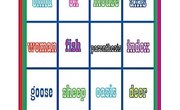Teaching combined sentences can be difficult, since combined sentences invoke complex rules of structure and punctuation. Lessons on combined sentences often involve dissecting sentences and sentence parts on the board so that student can better conceptualize ideas. But interactive games and activities that teach about combined sentences can also be used to help motivate sixth through eighth grade students to learn about this difficult area of grammar.
Hunting for Sentence Parts
In order to understand combined sentences, students need to understand the pattern and punctuation of combined sentences. When coordinators join sentences, a comma precedes the coordinator word. Therefore, the combined sentence follows the following pattern: clause, comma, coordinator, clause. Subordinators are more complex, because they involve a subordinate clause, a comma and an independent clause. When the subordinate clause precedes the independent clause, a comma separates the two clauses. When the subordinate clause follows the independent clause, there is no punctuation.
Teach students these concepts through a class game in which each student is assigned a sentence part, such as a clause, a comma or a coordinator word. To assign students sentence parts, write the sentence parts on index cards and then distribute one card per student. Instruct the students to get out of their seats and try to find the other students whose cards correspond to theirs. Once everyone has found the fellow students, each group should read their combined sentence to the class. The rest of the class should decide if it is correct or incorrect.
Concentration
The card game Concentration, sometimes called Memory, can be adapted to teach students about combining sentences with coordinators and subordinators. List commonly used coordinating words, such as for, and, nor, but, or, yet and so, on the back of an index card. Write one word per card. Then, on separate cards, list the relationship that the word invokes between two sentences. For instance, the word "but" combines contrasting sentences, while the word "or" combines alternative sentences. Do the same for frequently used subordinator words, such as although, though, while, because, if, unless, before, after and when. Students play the game by taking turns trying to match cards.
Go Fish
Another card game that can be adapted to teach combining sentences is Go Fish. Make playing cards by writing frequently used coordinator words and subordinator words on index cards, one word per card. Write the relationship that the word establishing between sentences on other words. Make several duplicate decks of cards and divide students into pairs to play the game. If time allows, the class can have a tournament in which winning players compete against each other until there is a final champion.
Race to Identify Combined Sentences
Assign students a page of text from a piece of literature or popular reading material. Make copies of the page so that each student has her own copy. Instruct students to read the text with the goal of identifying the number of combined sentences in the text. For a more challenging version of this activity, ask students to further identify the number of coordinating and subordinating combined sentences respectively. The first student to raise his hand with the correct answer wins. If time allows, repeat this activity with several passages.
Related Articles
Writer Bio
Audrey Farley began writing professionally in 2007. She has been featured in various issues of "The Mountain Echo" and "The Messenger." Farley has a Bachelor of Arts in English from the University of Richmond and a Master of Arts in English literature from Virginia Commonwealth University. She teaches English composition at a community college.










